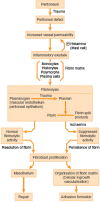The Future of Adhesion Prophylaxis Trials in Abdominal Surgery: An Expert Global Consensus
- PMID: 35329802
- PMCID: PMC8950418
- DOI: 10.3390/jcm11061476
The Future of Adhesion Prophylaxis Trials in Abdominal Surgery: An Expert Global Consensus
Abstract
Postoperative adhesions represent a frequent complication of abdominal surgery. Adhesions can result from infection, ischemia, and foreign body reaction, but commonly develop after any surgical procedure. The morbidity caused by adhesions affects quality of life and, therefore, it is paramount to continue to raise awareness and scientific recognition of the burden of adhesions in healthcare and clinical research. This 2021 Global Expert Consensus Group worked together to produce consented statements to guide future clinical research trials and advise regulatory authorities. It is critical to harmonize the expectations of research, to both develop and bring to market improved anti-adhesion therapies, with the ultimate, shared goal of improved patient outcomes.
Keywords: adhesion; antiadhesion agent; consensus; minimally invasive surgery.
Conflict of interest statement
The authors declare no conflict of interest.
Figures



References
-
- Stommel M.W.J., Ten Broek R.P.G., Strik C., Slooter G.D., Verhoef C., Grünhagen D.J., van Duijvendijk P., Bemelmans M.H.A., den Dulk M., Sietses C., et al. Multicenter Observational Study of Adhesion Formation After Open-and Laparoscopic Surgery for Colorectal Cancer. Ann. Surg. 2018;267:743–748. doi: 10.1097/SLA.0000000000002175. - DOI - PubMed
-
- Krielen P., Stommel M.W.J., Pargmae P., Bouvy N.D., Bakkum E.A., Ellis H., Parker M.C., Griffiths E.A., van Goor H., Ten Broek R.P.G. Adhesion-related readmissions after open and laparoscopic surgery: A retrospective cohort study (SCAR update) Lancet. 2020;395:33–41. doi: 10.1016/S0140-6736(19)32636-4. - DOI - PubMed
-
- DeWilde R.L., Trew G. Postoperative abdominal adhesions and their prevention in gynaecological surgery. Expert consensus position. Part 2 Steps to Reduce Adhesions. Gynecol. Surg. 2007;4:243–253. doi: 10.1007/s10397-007-0333-2. - DOI
LinkOut - more resources
Full Text Sources

